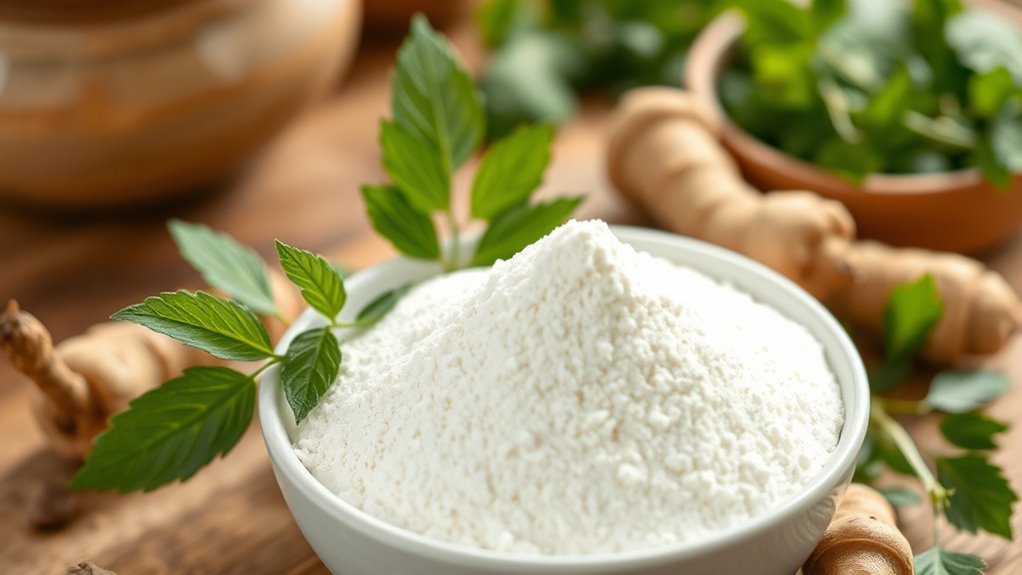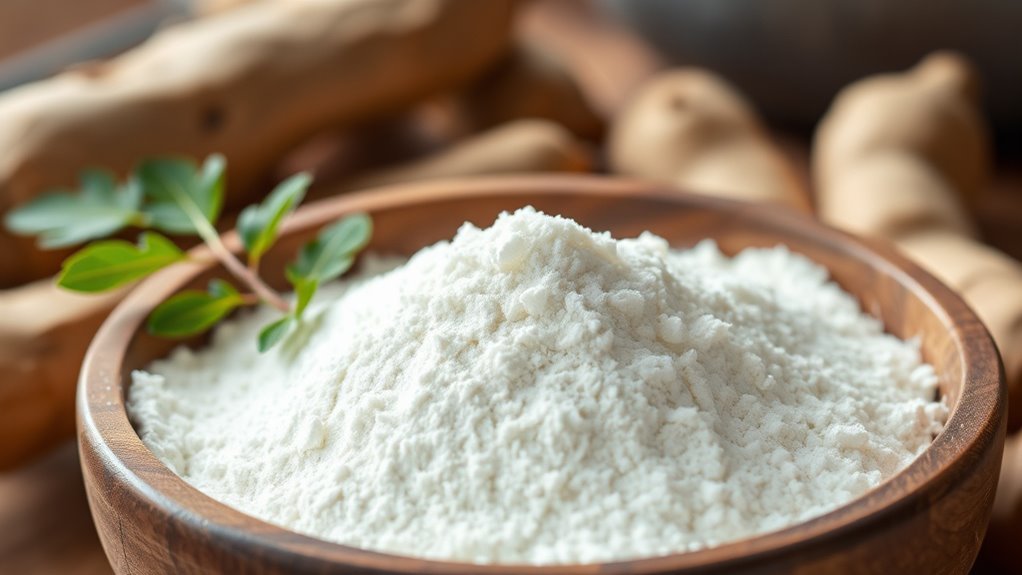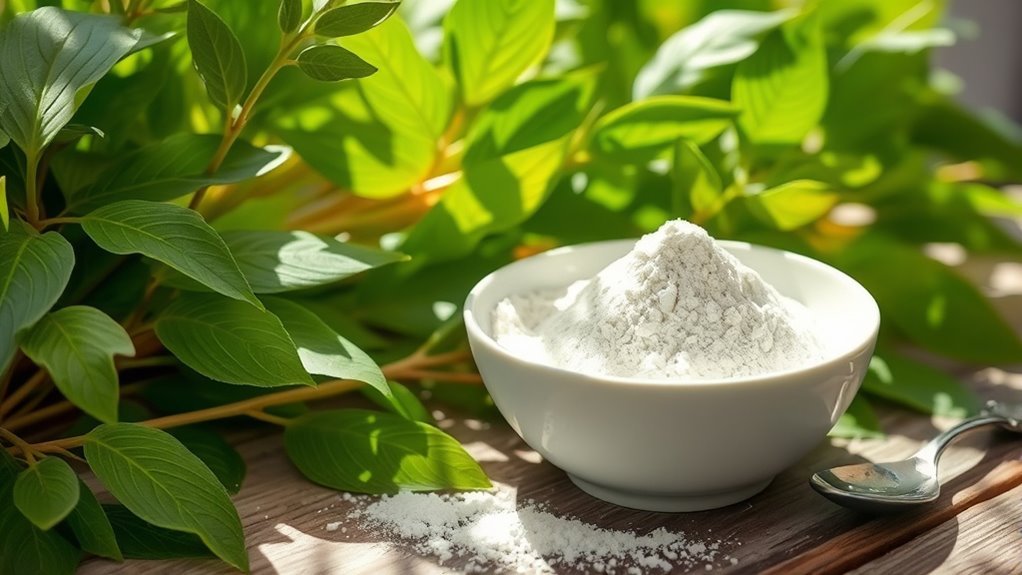Arrowroot isn’t keto-friendly due to its high carbohydrate content. With about 27 grams of carbs per 100 grams, consuming it in larger amounts can disrupt ketosis. While it offers health benefits like aiding digestion, its carb level makes it less suitable for strict ketogenic diets. You might consider using arrowroot sparingly or exploring keto-friendly alternatives that provide similar texture without the high carb count. There’s more to discover about your options and how to manage your diet effectively.
Understanding Arrowroot and Its Uses

Arrowroot is a starchy substance derived from the rhizomes of several tropical plants, primarily Maranta arundinacea. Its history dates back to the indigenous peoples of the Caribbean, who used it for various medicinal and culinary purposes. You might find arrowroot used as a thickening agent in sauces, soups, and puddings, making it a popular choice for gluten-free cooking. Additionally, its digestibility makes it suitable for infants and those recovering from illness. In some cultures, it’s even used in traditional remedies. As you explore arrowroot, you’ll appreciate its versatility and historical significance, offering a unique blend of nutrition and culinary application. Whether you’re cooking or seeking natural remedies, arrowroot has a place in your pantry.
Nutritional Profile of Arrowroot

When considering arrowroot, it’s important to look at its carbohydrate content and overall nutrient composition. You’ll find that arrowroot is primarily made up of carbohydrates, which can impact its suitability for a keto diet. Understanding these nutritional aspects will help you make an informed choice about including it in your meals.
Carbohydrate Content Analysis
While many are drawn to arrowroot for its potential health benefits, it’s essential to examine its carbohydrate content to determine its suitability for a keto diet. Arrowroot is primarily composed of carbohydrates, which can be counterproductive for those aiming to maintain a state of ketosis.
Here’s a quick look at arrowroot’s carbohydrate profile compared to some alternatives:
| Food Item | Carbohydrates (g) per 100g | Keto Friendly Substitute |
|---|---|---|
| Arrowroot | 72 | Almond Flour |
| Tapioca | 86 | Coconut Flour |
| Cornstarch | 91 | Ground Flaxseed |
| Potatoes | 17 | Zucchini |
| Sweet Potatoes | 20 | Cauliflower Rice |
Considering these figures, if you’re looking for keto-friendly substitutes, arrowroot might not be your best bet.
Nutrient Composition Overview
Although many people appreciate arrowroot for its culinary uses, understanding its nutritional profile is essential for making informed dietary choices. Arrowroot primarily consists of carbohydrates, with minimal protein and fat, making it a quick source of energy. Its main nutrient sources include starch, which can provide health benefits like improved digestion and energy release. Rich in B vitamins, potassium, and iron, arrowroot supports overall well-being. It’s also gluten-free, making it a suitable option for those with dietary restrictions. However, if you’re pursuing a strict keto diet, its high carbohydrate content might not align with your goals. Balancing arrowroot with other low-carb foods can help you enjoy its benefits while maintaining your desired macronutrient ratios.
Carbohydrate Content in Arrowroot

When considering arrowroot, it’s important to look closely at its carbohydrate content, which is relatively high compared to typical keto foods. A standard serving contains about 30 grams of carbohydrates, making it less suitable for a strict ketogenic diet. By comparing arrowroot to other low-carb alternatives, you can better understand its place in your dietary choices.
Arrowroot Nutritional Profile
Arrowroot, a starchy root vegetable often used as a thickening agent, has a nutritional profile that raises questions for those following a ketogenic diet. With approximately 24 grams of carbohydrates per 100 grams, it’s clear that arrowroot might not fit into a strict keto lifestyle. However, arrowroot benefits include being easy to digest and gluten-free, making it a popular choice for those with dietary restrictions. If you’re looking for alternatives, consider options like almond flour or coconut flour, which offer lower carbohydrate counts while still providing similar culinary results. Ultimately, while arrowroot can serve a purpose in certain diets, it’s essential to evaluate its role carefully if you’re aiming for ketosis.
Comparison With Keto Foods
While many people turn to low-carb options to maintain ketosis, comparing arrowroot’s carbohydrate content to that of keto-friendly foods reveals significant differences. Arrowroot, with approximately 80 grams of carbs per 100 grams, is far from ideal for a keto diet. In contrast, keto-friendly substitutes offer much lower carb counts, making them more suitable for those seeking to stay in ketosis.
Here’s a quick comparison:
| Food Item | Carbohydrate Content (per 100g) |
|---|---|
| Arrowroot | 80g |
| Almond Flour | 10g |
| Coconut Flour | 24g |
| Chia Seeds | 42g |
| Broccoli | 7g |
If you’re looking for arrowroot alternatives, consider these keto-friendly substitutes to help you maintain your low-carb lifestyle.
Arrowroot vs. Other Thickeners
Although many people turn to various thickeners for their cooking needs, understanding how arrowroot compares to other options is essential, especially for those following a keto diet. Arrowroot is a popular thickening agent, but it isn’t always the best choice for low-carb lifestyles. When considering arrowroot alternatives, options like xanthan gum or guar gum can be more keto-friendly, as they contain fewer carbohydrates. These thickeners require smaller amounts to achieve the desired consistency, making them more efficient for keto cooking. Additionally, they don’t alter the flavor of your dishes considerably. While arrowroot offers a gluten-free option, it’s wise to evaluate the carbohydrate content and effectiveness of various thickening agents to meet your dietary goals.
Potential Benefits of Arrowroot
When exploring thickeners, it’s worth noting that arrowroot does offer some potential benefits. This gluten alternative can be a valuable addition to your diet, especially if you’re looking for ways to enhance your meals. Here are three notable benefits:
- Digestive Support: Arrowroot is gentle on the stomach and can aid digestion, making it a great option for those with sensitive systems.
- Nutrient Absorption: Its properties may help increase the absorption of nutrients, contributing to overall health benefits.
- Weight Management: Being low in calories yet high in dietary fiber, arrowroot can serve as an effective energy source while helping you feel full, promoting weight management.
Incorporating arrowroot into your culinary uses could be a smart choice for your health journey.
Drawbacks of Arrowroot for Keto Dieters
If you’re following a keto diet, you’ll want to be cautious with arrowroot due to its high carbohydrate content. While it’s often praised for its thickening abilities, it can greatly impact your daily carb allowance. Arrowroot contains around 27 grams of carbs per 100 grams, which isn’t ideal for keto dieters.
Here’s a quick comparison of arrowroot and some keto-friendly alternatives:
| Thickener | Carbs (per 100g) | Keto-Friendly? |
|---|---|---|
| Arrowroot | 27g | No |
| Xanthan Gum | 7g | Yes |
| Guar Gum | 8g | Yes |
Consider these arrowroot alternatives for your recipes to maintain ketosis while still enjoying your meals!
How to Incorporate Arrowroot Into a Keto Diet
While incorporating arrowroot into a keto diet can be challenging due to its high carbohydrate content, there are strategic ways to use it in moderation. Here are three ideas to take into account:
- Thickening Agent: Use arrowroot in small amounts as a thickener for sauces or soups, balancing it with low-carb ingredients to keep overall carbs in check.
- Arrowroot Recipes: Look for recipes that combine arrowroot with keto-friendly foods, like using it in a low-carb dessert to achieve a pleasant texture.
- Keto Substitutions: Think about substituting arrowroot for other higher-carb thickeners in your favorite dishes, which can help manage your carb intake while exploring new flavors.
With these strategies, you can enjoy arrowroot without derailing your keto goals.
Final Thoughts on Arrowroot and Keto
Although arrowroot can be a tempting ingredient due to its culinary versatility, it’s essential to recognize its limitations within a keto diet. High in carbohydrates, it doesn’t align with the low-carb principles of keto. If you’re seeking to maintain ketosis, consider arrowroot alternatives like almond flour or coconut flour, which provide similar texture without the carb load. You can also experiment with keto modifications in your recipes, such as using xanthan gum or psyllium husk as thickeners. Embracing these alternatives allows you to enjoy the culinary freedom you seek while sticking to your dietary goals. Ultimately, it’s about finding the right balance and making informed choices that align with your lifestyle.
Frequently Asked Questions
Can Arrowroot Cause Digestive Issues for Some Individuals?
Imagine your stomach as a delicate garden, where every ingredient can either nourish or disrupt. For some individuals, arrowroot might cause digestive sensitivity, leading to discomfort. It’s relatively rare, but arrowroot allergies can occur, triggering issues like bloating or gas. If you’ve experienced such symptoms after consuming it, it’s wise to consult with a healthcare professional. Everyone’s digestive system is unique, so it’s essential to listen to your body’s signals.
Is Arrowroot Gluten-Free and Safe for Celiac Patients?
Yes, arrowroot is gluten-free and safe for celiac patients. Its benefits include being easily digestible and low in allergens, making it a great alternative to gluten-containing grains. For those with celiac disease, choosing arrowroot can provide a safe option for thickening sauces or baking. Just make sure it’s processed in a gluten-free facility to avoid cross-contamination. Enjoy its versatility while maintaining your dietary needs with confidence!
Can Arrowroot Be Used in Vegan Recipes?
Did you know that around 3% of the U.S. population identifies as vegan? If you’re looking for a versatile ingredient, arrowroot can be a fantastic addition to your vegan recipes. It’s gluten-free and serves as a great thickening agent, making it a popular alternative to cornstarch in sauces and desserts. Plus, its arrowroot benefits include being easily digestible, providing a perfect substitute for eggs in some baking. Enjoy experimenting with this plant-based gem!
How Does Arrowroot Impact Blood Sugar Levels?
Arrowroot can impact blood sugar levels by providing a source of carbohydrates that may lead to a moderate insulin response. When you consume arrowroot, your body breaks it down into glucose, which can raise blood sugar levels. However, its glycemic index is relatively low compared to other starches, meaning it may not cause rapid spikes. If you’re mindful of your overall carbohydrate intake, you can enjoy it in moderation without significant blood sugar concerns.
What Are Alternatives to Arrowroot in Cooking?
So, you’re stuck in a culinary conundrum, wondering how to replace arrowroot like it’s the Holy Grail of cooking? Fear not! Tapioca starch can swoop in as a trusty sidekick, offering a similar thickening power. If you’re feeling rebellious, cornstarch’s got your back too—just use half the amount! These alternatives promise to keep your dishes delicious while maintaining that desired texture. Now, go forth and cook with confidence!


